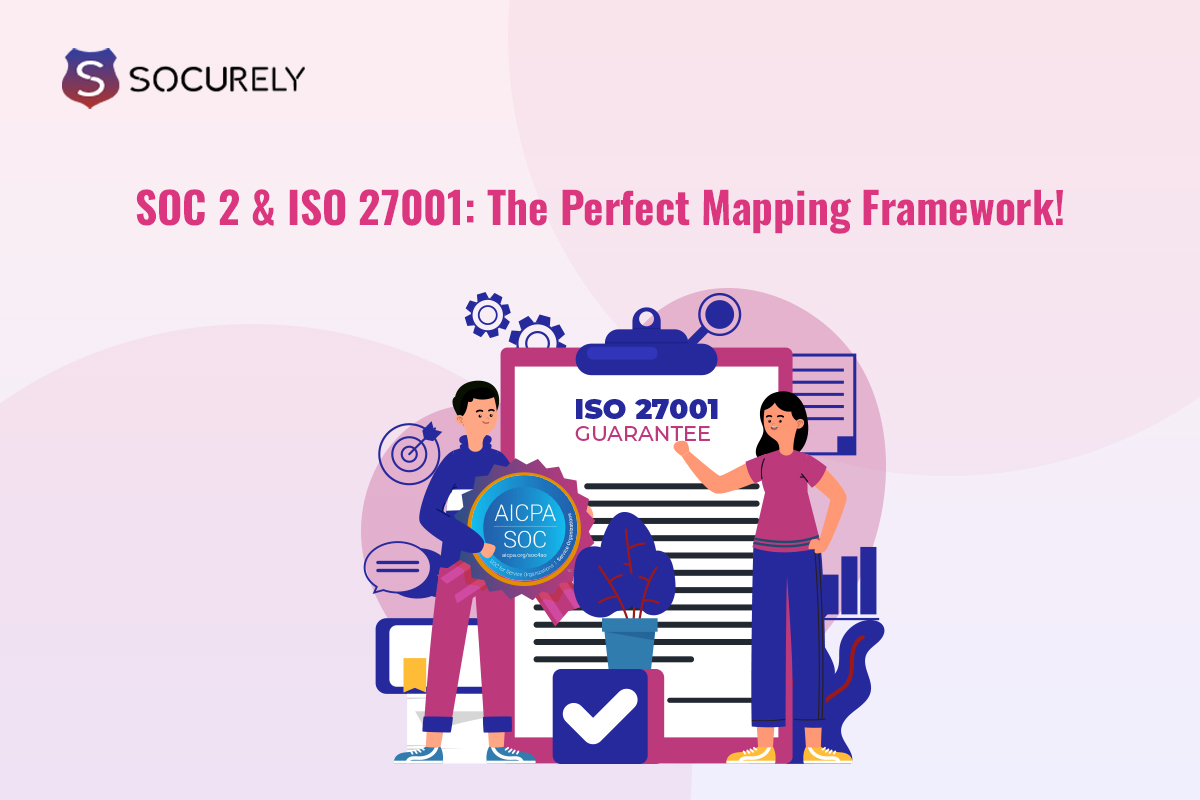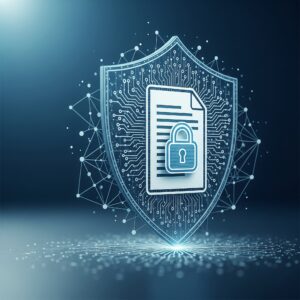The stakes are high, with an IBM report revealing that the average cost of a data breach in 2023 reached a staggering $4.45 million. As organizations strive to protect their sensitive information and gain a competitive edge, the demand for robust security frameworks has never been greater. Enter SOC 2 and ISO 27001—two of the most respected standards in the field of information security.
But why choose between them when you can have the best of both worlds?
Mapping SOC 2 criteria to ISO 27001 standards provides a comprehensive, aligned approach to information security that ensures your organization meets the highest compliance standards while streamlining your audit processes.
What Is SOC 2 & ISO 7001 Compliance Framework?
SOC 2 (System and Organization Controls 2) and ISO 27001 (International Organization for Standardization 27001) are two globally recognized standards designed to ensure organizations implement and maintain effective information security controls. While both frameworks aim to protect sensitive data, they have different focuses and approaches.
SOC 2 Compliance-
Customer data is managed following five key trust service principles outlined in SOC 2. It’s primarily used by service providers to demonstrate that they have adequate controls in place to safeguard customer data.
ISO 27001 Compliance-
On the other hand, ISO 27001 is an internationally recognized standard that specifies the requirements for establishing, implementing, maintaining, and continually improving an Information Security Management System (ISMS). This framework takes a risk-based approach, ensuring that all aspects of an organization’s information security are addressed systematically.
What are SOC 2 and ISO 27001 Mapping?
Mapping SOC 2 to ISO 27001 involves aligning the criteria and controls of SOC 2 with those of ISO 27001 to create a cohesive, unified framework that meets the requirements of both standards. This process is crucial for organizations looking to simplify their compliance efforts, reduce redundancy, and ensure they adhere to best practices in information security.
Many businesses decide to strive for compliance with different security requirements. The AICPA maps the Common Criteria onto ISO 27001 requirements, among other specifications for other frameworks like SOC 2.
Together, these frameworks offer a comprehensive approach to protecting data, ensuring both regulatory compliance and building trust with clients and stakeholders.
What Common Criteria Do SOC 2 and ISO 27001 Compliance Share?
If your company intends to adopt both ISO 27001 and SOC 2, you’re in luck because there are many similarities between these two standards.
Mapping SOC 2 criteria to ISO 27001 involves identifying the overlapping areas between the two frameworks and aligning their respective controls.
The exact controls that make SOC 2 are encapsulated in a set of five guiding principles known as the Trust Services Criteria:
- Availability of Security
- Keeping Information Private
- Processing Integrity for Privacy, and Confidentiality
The ten “clauses” that include up ISO 27001 controls cover an organization’s security responsibilities.
- Scope
- Normative references
- Terms and definitions
- Context
- Leadership
- Planning and risk management
- Support
- Operations
- Performance evaluation
- Improvement
Here’s a breakdown of some common mappings:
- Security (SOC 2) vs. Annex A.5-A.18 (ISO 27001):
- Both frameworks emphasize the need for robust security measures to protect sensitive information. ISO 27001’s Annex A controls, which cover areas such as access control, cryptography, and physical security, can be mapped to SOC 2’s Security criteria.
- Availability (SOC 2) vs. Annex A.17 (ISO 27001):
- SOC 2’s Availability criteria focus on ensuring that systems are operational and accessible as required by service agreements. This aligns with ISO 27001’s Business Continuity Management controls (A.17), which address the need for resilience and disaster recovery planning.
- Confidentiality (SOC 2) vs. Annex A.8 (ISO 27001):
- Both standards emphasize the protection of confidential information. ISO 27001’s Information Classification controls (A.8) can be directly mapped to SOC 2’s Confidentiality criteria, ensuring that sensitive data is appropriately classified and safeguarded.
- Processing Integrity (SOC 2) vs. Annex A.12 (ISO 27001):
- SOC 2’s Processing Integrity criteria ensure that systems operate as intended, without errors or unauthorized changes. This is closely related to ISO 27001’s Operational Security controls (A.12), which focus on secure system operations and change management.
- Privacy (SOC 2) vs. Annex A.18 (ISO 27001):
- SOC 2’s Privacy criteria align with ISO 27001’s Compliance controls (A.18), which address the need to comply with applicable legal and regulatory requirements, including data protection laws.
What is SOC 2 vs. ISO 27001 control mapping?
Control mapping is the process of aligning specific controls from SOC 2 with corresponding controls in ISO 27001. This allows organizations to streamline their compliance efforts by identifying areas where the two standards overlap and ensuring that their controls meet the requirements of both frameworks.
The primary focus in control mapping is on the alignment of specific control needs between two sets of controls. Finding areas of overlap, similarities, or gaps between controls is the aim of control mapping, ensuring that the appropriate controls are in place to meet the needs of both frameworks.
The mapping will be contingent upon the particular controls delineated in your ISO 27001 implementation and your SOC 2 report.
For example, by mapping SOC 2’s access control requirements to ISO 27001’s Annex A.9 controls, organizations can ensure that they meet the access control requirements of both standards with a single set of controls.
Controls that can be translated from SOC 2 to ISO 27001 include the following examples:
Incident Response
- SOC 2 Control- Identify, handle, and recover from security issues by developing an incident response strategy (SOC 2 Control).
- ISO 27001 Control- Create and implement an incident management plan to control and minimize the impact of information security incidents.
Access Control-
- SOC 2 Control- Establish and carry out logical access controls to prevent unauthorized users from accessing data and systems.
- ISO 27001 Control- Control to ensure authorized access to information systems and prevent unauthorized access.
Physical Security-
- SOC 2 Control- Put in place physical security measures to prevent unwanted access to equipment, premises, and private information.
- ISO 27001 Control- To protect physical assets and prevent unwanted access, set up physical security perimeters, access controls, and monitoring systems.
Control Management-
- SOC 2 Control- Establish change management procedures to ensure that alterations to applications and systems are properly approved and tested.
- ISO 27001 Control- To manage information system changes and minimize business disruptions, put in place a methodical change management strategy.
Vendor Management-
- SOC 2 Control- To assess and manage the risks associated with employing outside service providers, implement a vendor management program.
- ISO 27001 Control- Establish a process for evaluating, selecting, and monitoring the information security precautions that outside vendors follow.
Data Backup and Recovery-
- SOC 2 Control- Test the efficacy of data backup and recovery protocols and regularly back up important data.
- ISO 27001 Control- To guarantee data availability and integrity, put in place a backup plan and test data restoration processes regularly.
Benefits of SOC 2 and ISO 27001 criteria mapping
Mapping SOC 2 criteria to ISO 27001 offers several key benefits:
- By aligning the requirements of SOC 2 and ISO 27001, organizations can reduce duplication of effort and streamline their compliance processes. This makes it easier to manage and maintain compliance with both standards, saving time and resources.
- Mapping SOC 2 to ISO 27001 ensures that organizations implement a comprehensive set of controls that address all aspects of information security. This helps to strengthen the organization’s overall security posture and reduce the risk of data breaches.
- Achieving compliance with both SOC 2 and ISO 27001 demonstrates a strong commitment to information security, which can help to build trust and confidence among clients, partners, and stakeholders.
- Organizations that are compliant with both SOC 2 and ISO 27001 are often seen as more trustworthy and reliable than their competitors, giving them a competitive edge in the marketplace.
- By mapping SOC 2 criteria to ISO 27001, organizations can reduce the number of audits they need to undergo, minimizing audit fatigue and disruption to their operations.
- The mapping process helps organizations to identify and address potential risks more effectively, improving their overall risk management capabilities.
Socurely’s thoughts on SOC 2 vs. ISO 27001 criteria mapping
In summary, translating ISO 27001 vs. SOC 2 criteria is similar to piecing together the ideal jigsaw pieces. Companies are not obligated to adhere to every single set of guidelines and procedures found in SOC 2 and ISO 27001 standards. How then do you decide which to cling to? Getting expert guidance on the best course of action is possible when you collaborate with a reliable compliance partner like Socurely
Our team at Socurely is here to help you navigate the mapping process, offering expert guidance and support to ensure that your organization achieves and maintains compliance with both SOC 2 and ISO 27001. By automating the gathering of evidence, providing structured implementation, and ongoing monitoring, Socurely goes above and beyond to save you time and money.
FAQ’s
How can businesses make sure the mapping of SOC 2 to ISO 27001 is successful?
- Businesses should start by conducting a thorough gap analysis to identify areas where their existing controls align with the requirements of both standards. It’s also important to engage with experienced professionals who can provide guidance and support throughout the mapping process.
Should businesses regularly update their mapping?
- Yes, businesses should regularly review and update their mapping to ensure that it remains aligned with the latest versions of SOC 2 and ISO 27001. This will help to ensure that their controls continue to meet the requirements of both standards.
Is compliance with both SOC 2 and ISO 27001 guaranteed by mapping SOC 2 to ISO 27001?
- While mapping SOC 2 to ISO 27001 can help organizations streamline their compliance efforts, it does not guarantee compliance. Organizations must still undergo regular audits to demonstrate that their controls are effective and meet the requirements of both standards.







